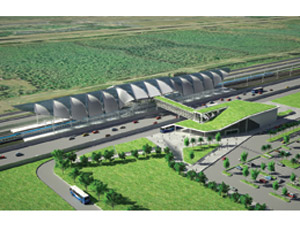The lines on the developing U.S. high-speed-rail map have been barely penciled in, and now, after the Nov. 2 elections, at least two lines probably will have to be erased. Republican governors-elect in Wisconsin and Ohio vow to halt work on rail projects in their states, even though they won U.S Dept. of Transportation funds. Florida’s incoming GOP governor has promised to kill a proposed Orlando-Tampa line if state funding is required.


Despite those developments, rail plans are rolling ahead in more than two dozen other states, thanks partly to infusions of federal aid. Some of those states are hungry for any federal rail money that Wisconsin, Ohio or Florida may return.
U.S. Transportation Secretary Ray LaHood said on Nov 15 he will make an announcement “very soon” about reallocating the more than $1.2 billion that governors-to-be in Wisconsin and Ohio plan to give back to Uncle Sam.
“We are still compiling a list of states in a position to spend the money,” LaHood told attendees at a U.S. High Speed Rail Association conference in New York City. “A lot of states would like to have access to that money.” If issues arise about state costs of operations and meeting federal requirements, “we will work through them,” LaHood added.
Karen J. Rae, deputy administrator of DOT’s Federal Railroad Administration, says, “Many of the other governors-elect have gone on the record and said, ‘We’ll take it.’ … There is a huge amount of interest, and though we have some educating to do nationally, the momentum is continuing.”
California swam against the tide on Nov. 2, electing Democrat Jerry Brown, whose campaign plan included support for high-speed rail. The state has won nearly $3.2 billion so far for its rail plan from U.S. DOT and has $9 billion in bonds to complement the federal dollars.Rachel Wall, a California High Speed Rail Authority spokeswoman, says, “If other states are giving the money back, we will use it and use it well.”
Although Wisconsin’s governor-elect, Scott Walker, and Ohio’s incoming governor, John Kasich, have staked out strong anti-rail positions, U.S. DOT officials still were having conversations with both in mid-November. But LaHood has made it clear in letters to Walker and Kasich that they cannot use already awarded federal high-speed-rail money for other purposes, such as highway improvements.
Walker has promised to kill an 80-mile-long high-speed-rail link between Madison, Wisconsin’s capital, and Milwaukee, its largest city. Halting the project would mean the state would forfeit the $822 million in federal grants that would have financed the link’s entire design and construction.
Outgoing Gov. Jim Doyle (D), a strong rail supporter, says he won’t end project work before leaving office. “To me, it doesn’t make sense not to move ahead, but we have had an election,” he says.
Doyle adds that stopping the project will cost Wisconsin about $96 million, including $14 million for work completed and $82 million for work on the existing Milwaukee-Chicago Hiawatha line, which will lose eligibility for federal funds.
He says a cancellation probably will cost 412 jobs immediately, including 70 engineering consultant jobs, 10 state employees, 272 construction positions, and 60 Canadian Pacific Railway engineering and design consultants.
In Ohio, Governor-elect John Kasich has said he will cancel about $400 million of federally funded work for an envisioned system connecting Cleveland, Columbus, Dayton and Cincinnati.
Until Kasich takes office, however, current Gov. Ted Strickland (D) will keep the project moving. “The governor believes Ohio should take advantage of this once-in-a-lifetime opportunity from the federal government to re-establish passenger rail in Ohio,” says Strickland spokeswoman Amanda Wurst.
To Scott Varner, Ohio’s transportation deputy director, continuing the state’s current high-speed-rail work makes sense. He says, “We are now doing preliminary work and gathering information that will be good to have even if the governor-elect decides not to move forward.”
Ohio DOT and its consultants, led by Parsons Brinckerhoff, are completing the final environmental study, preparing for negotiations with freight-rail companies (whose tracks the high-speed passenger system will use when possible) and just starting design engineering.
Varner adds, “We are not yet to the point where we are spending capital on tracks, equipment and construction.”
 Rick Scott |
FLORIDA $ 2.06B Total federal funds awarded Rail Line: Orlando-Tampa |
 John Kasich |
OHIO $ 400M Total federal funds awarded Rail Lines: Cleveland-Columbia-Cincinnati |
 Scott Walker |
WISCONSIN $ 822M Total federal funds awarded Rail Lines: Madison-Milwaukee, Milwaukee-Chicago |
In Florida, incoming Gov. Rick Scott’s anti-rail position put what U.S. Sen. Bill Nelson (D-Fla.) called “a cloud of uncertainty” over a rail industry forum that drew about 1,500 attendees to Orlando, including many interested in bidding on upcoming rail contracts in the Sunshine State. Speaking on Nov. 8 at the forum, Nelson said, “[The rail link] could be one of the biggest boosts to Florida’s economy since Disney and [since] Eisenhower created the Interstate system.”
The 84-mile first phase, from Tampa to the Orlando International Airport, would include five stations, including stops at Lakeland, Disney World and the Orange County Convention Center, among others.
Even with the $2 billion from U.S. DOT, FDOT estimates the state still is short $350 million. The agency wants potential bidders on its design-build-operate-maintain-finance contract package to include that sum in their proposals.
Some teams hoping to receive the umbrella DBOMF contract remain upbeat. Michael C. Turner, a program manager with Skanska USA Civil, part of the Florida Rail Ventures consortium, says, “[My team] feels it’s a great project, and with the amount of federal funds and the jobs it will create, I’m sure the governor will do due diligence. But we are confident the job will go, given the funding in place.”
Ian Rainey, co-manager of Florida High-Speed Rail, a consortium that includes Fluor Corp. and Balfour Beatty, says of Scott, “He’s not closing down the project. He wants to take a look at the numbers to see if it makes sense.”
Regardless of Scott’s decision, FDOT plans to advertise its first of five “early-works” packages in mid-November and issue a request for qualifications on the DBOMF contract by early December. The five early-works contracts total $170 million. They would begin in 2011 and finish before the concessionaire starts rail-line construction in late 2012—if Scott gives the green signal.


Post a comment to this article
Report Abusive Comment